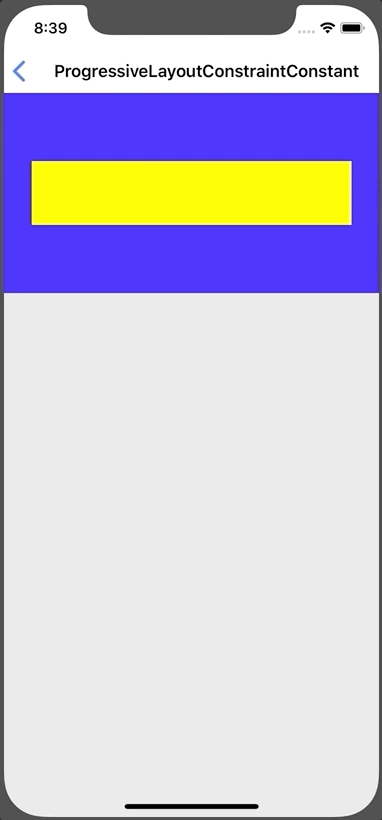A container view that responds to scrolling of UIScrollView.
| normal | threshold |
|---|---|
 |
 |
The enum used in the FlexibleHeader class to determine the header type.
public enum FlexibleHeaderExecutantType {
case normal
case threshold
case customThreshold(hiddenThreshold: CGFloat, showThreshold: CGFloat)
}Header appears when offset Y of scroll is 0. In other cases, the Header is disappeared.
Unlike the normal type, the header can be appeared or disappeared in the middle of the scroll by the threshold.
You can set hidden threshold and show threshold to threshold type. The unit of threshold is the offset of UIScrollView.
The container view that contains the UIScrollView and the FlexibleHeader is the easiest way to implement a FlexibleHeader.
- Create an instance of FlexibleHeaderScrollView.
let flexibleHeaderScrollView = FlexibleHeaderScrollView(headerMaxHeight: 64, headerMinHeight: 0, headerExecutantType: .threshold)
flexibleHeaderScrollView.translatesAutoresizingMaskIntoConstraints = false- Add subviews to the contentView in FlexibleHeaderScrollView.
let topView = UIView()
topView.translatesAutoresizingMaskIntoConstraints = false
let bottomView = UIView()
bottomView.translatesAutoresizingMaskIntoConstraints = false
topView.leadingAnchor.constraint(equalTo: flexibleHeaderScrollView.contentView.leadingAnchor).isActive = true
topView.topAnchor.constraint(equalTo: flexibleHeaderScrollView.contentView.topAnchor).isActive = true
topView.trailingAnchor.constraint(equalTo: flexibleHeaderScrollView.contentView.trailingAnchor).isActive = true
topView.heightAnchor.constraint(equalToConstant: 550).isActive = true
bottomView.leadingAnchor.constraint(equalTo: flexibleHeaderScrollView.contentView.leadingAnchor).isActive = true
bottomView.topAnchor.constraint(equalTo: topView.bottomAnchor).isActive = true
bottomView.trailingAnchor.constraint(equalTo: flexibleHeaderScrollView.contentView.trailingAnchor).isActive = true
bottomView.heightAnchor.constraint(equalToConstant: 550).isActive = true
bottomView.bottomAnchor.constraint(equalTo: flexibleHeaderScrollView.contentView.bottomAnchor).isActive = trueIf you want to implement the FlexibleHeader functionality in your UIScrollView, use the FlexibleHeader class.
- Create an instance of UIScrollView.
let scrollView = UIScrollView()
scrollView.translatesAutoresizingMaskIntoConstraints = false- Create an instance of FlexibleHeader using an instance of UIScrollView.
let flexibleHeader = FlexibleHeader(scrollView: scrollView, maxHeight: 64, minHeight: 0, executantType: .threshold)
flexibleHeader.translatesAutoresizingMaskIntoConstraints = false- Configure a height NSLayoutConstraint of an instance of FlexibleHeader.
let flexibleHeaderHeight = flexibleHeader.heightAnchor.constraint(equalToConstant: 50)
flexibleHeaderHeight.isActive = true
flexibleHeader.configure(heightConstraint: flexibleHeaderHeight)You can change the value(view properties, constant of NSLayoutConstraint) based on the start and end points as the scroll progress.
let flexibleHeader = FlexibleHeader(scrollView: scrollView, maxHeight: 128, minHeight: 0, executantType: .threshold)
let initialAttribute = ProgressiveViewAttribute(view: flexibleHeader, progress: 0.0, alpha: 1.0)
let finalAttribute = ProgressiveViewAttribute(view: flexibleHeader, progress: 1.0, alpha: 0.0)
flexibleHeader.appendProgressiveViewAttribute(with: initialAttribute)
flexibleHeader.appendProgressiveViewAttribute(with: finalAttribute)let headerContentView = UIView()
headerContentView.translatesAutoresizingMaskIntoConstraints = false
headerContentView.backgroundColor = .yellow
flexibleHeader.addSubview(headerContentView)
headerContentView.centerXAnchor.constraint(equalTo: flexibleHeader.centerXAnchor).isActive = true
headerContentView.centerYAnchor.constraint(equalTo: flexibleHeader.centerYAnchor).isActive = true
headerContentView.heightAnchor.constraint(equalToConstant: 64).isActive = truelet headerContentViewWidth = headerContentView.widthAnchor.constraint(equalToConstant: 0)
headerContentViewWidth.isActive = true
let initialConstraintConstant = ProgressiveLayoutConstraintConstant(constraint: headerContentViewWidth, progress: 0.0, constant: 320)
let finalConstraintConstant = ProgressiveLayoutConstraintConstant(constraint: headerContentViewWidth, progress: 1.0, constant: 0)
flexibleHeader.appendProgressiveConstraintConstant(with: initialConstraintConstant)
flexibleHeader.appendProgressiveConstraintConstant(with: finalConstraintConstant)platform :ios, '9.0'
use_frameworks!
target '<Your Target Name>' do
pod 'FlexibleHeader'
endgithub "k-lpmg/FlexibleHeader"These works are available under the MIT license. See the LICENSE file for more info.






